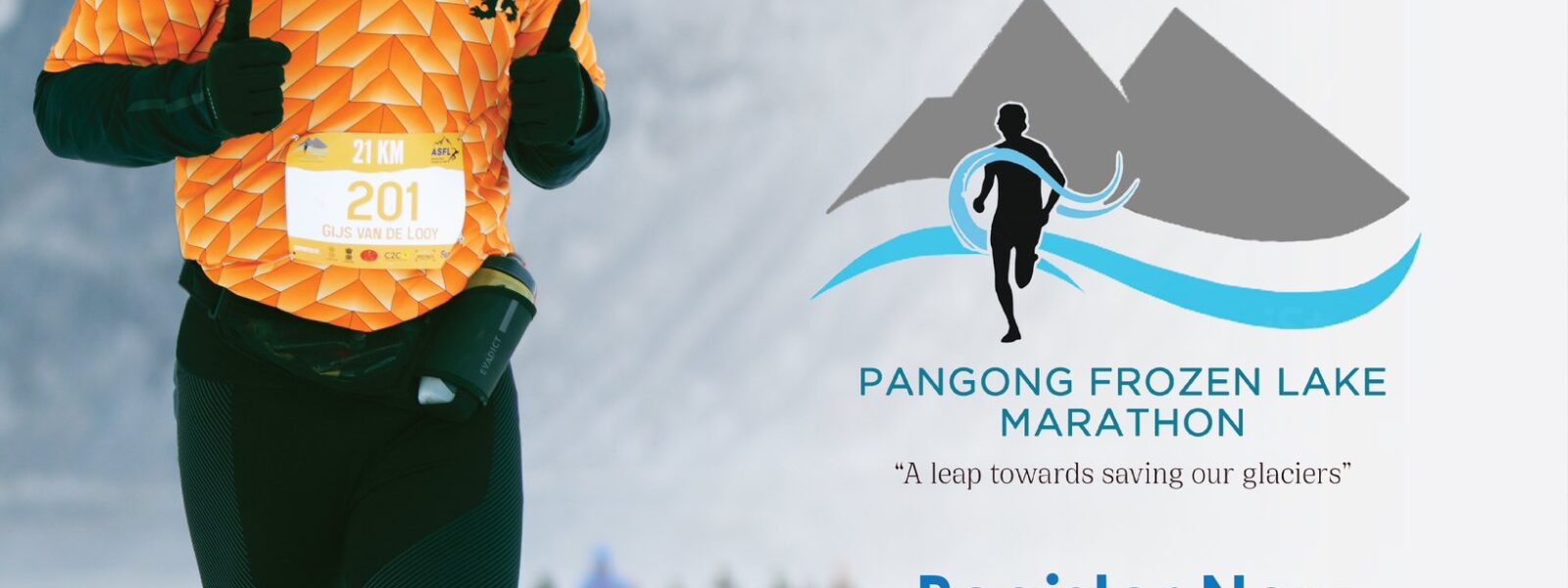Running on Ice at the Edge of the Sky
Where Silence Becomes a Race
The call of Pangong in winter
Each winter, when most travelers retreat from the Himalayas, the vast expanse of Pangong Lake transforms into a sheet of shimmering ice. At over 4,200 meters above sea level, this lake—half in India, half in Tibet—freezes into a mirror that reflects the endless blue of the Ladakhi sky. It is here that the Pangong Frozen Lake Marathon takes place, an event so unique that it defies comparison. Runners from across the world gather in this high-altitude wilderness, where temperatures can plunge below –25°C, to test not just their bodies, but the limits of human resilience. The lake’s silence becomes their companion; each breath, a visible cloud of effort against the frozen horizon.
Why runners come to Ladakh for this challenge
The Pangong Frozen Lake Marathon is not a typical athletic event—it’s a pilgrimage into isolation and beauty. For seasoned runners, the challenge lies not only in distance but in endurance under extreme conditions. For first-time participants, it’s a lesson in humility before nature. The frozen surface creaks beneath their feet, the altitude makes each step feel heavier, yet the sheer grandeur of Pangong Tso pushes them forward. Many describe the experience as transformative—a reminder of how small yet strong the human spirit can be. The marathon’s motto, “Racing Beyond Limits,” captures that truth perfectly. It is not about speed but survival, not about victory but discovery.
A landscape sculpted by silence and endurance
Beyond the runners and the race, Pangong itself becomes a protagonist. Wind carves ripples into the frozen surface, sunlight glitters on patterns of blue and white, and mountains rise like silent guardians. This environment demands respect; a misstep could lead to frostbite or fatigue. But it also rewards courage with moments of profound stillness—those rare seconds when a runner glides across the ice and realizes that endurance here is not only physical. It is spiritual. In this place, the marathon is less a competition and more a meditation in motion, an ode to resilience under the sky of the Himalayas.
Pangong Frozen Lake Marathon 2026: New Frontiers on Ice
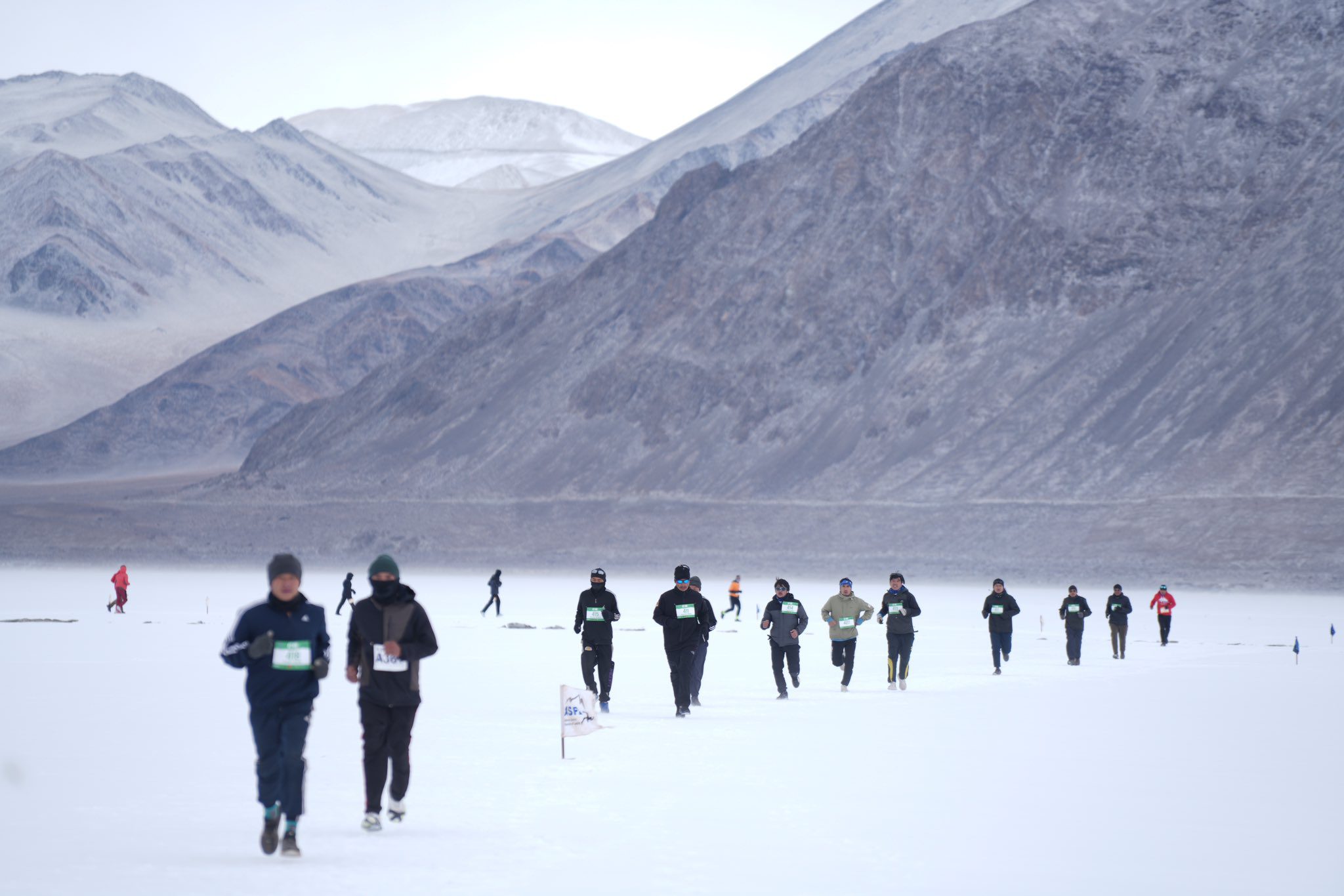
The story behind the world’s highest frozen lake marathon
Born from a local dream to promote sustainable tourism in Ladakh, the Pangong Frozen Lake Marathon has become an international symbol of adventure and responsibility. Its 2026 edition carries the theme “The Last Run,” reminding participants that glaciers and frozen lakes like Pangong are vanishing due to climate change. Organized by Adventure Sports Foundation of Ladakh (ASFL), this marathon is not just a race—it’s a statement. The event holds the Guinness World Record as the world’s highest frozen lake marathon, a recognition that brings both pride and urgency. Each kilometer is run on ice that might not exist in decades to come, making every step both celebration and warning.
Dates, distances, and categories for 2026
The 2026 edition is set to unfold in late February, when the ice reaches its peak thickness. The main event, the Full Marathon, will be held on February 24, 2026, followed by the Half Marathon and Amateur Run on February 25. For ultra-runners, a new category—Pangong Ice Ultra (55 km)—adds a formidable layer of endurance. Distances vary, but all share one constant: running entirely on ice at an altitude of over 13,800 feet. The course passes through frozen corridors flanked by the villages of Lukung, Spangmik, and Maan, areas where local communities assist with logistics and hospitality. Safety checkpoints every five kilometers ensure constant medical supervision, while aid stations offer hot water and energy support to combat dehydration in the cold.
Extreme conditions that test body and spirit
Running at this altitude requires adaptation. Oxygen levels drop to nearly 60% of sea-level availability, meaning that every breath demands conscious effort. The cold burns through calories faster than runners expect, and hydration becomes a subtle battle against dry air. But for those who prepare well, the reward is incomparable: the sensation of running across one of the most beautiful natural arenas on Earth. The marathon route traces the lake’s frozen surface, with mountains reflecting perfectly on the ice. It’s as if nature has carved a track of crystal for a select few who dare to step upon it. Many finishers recall moments when the world fell completely silent—only the crunch of their spikes echoing across eternity.
Course Layout and Challenges on the Ice
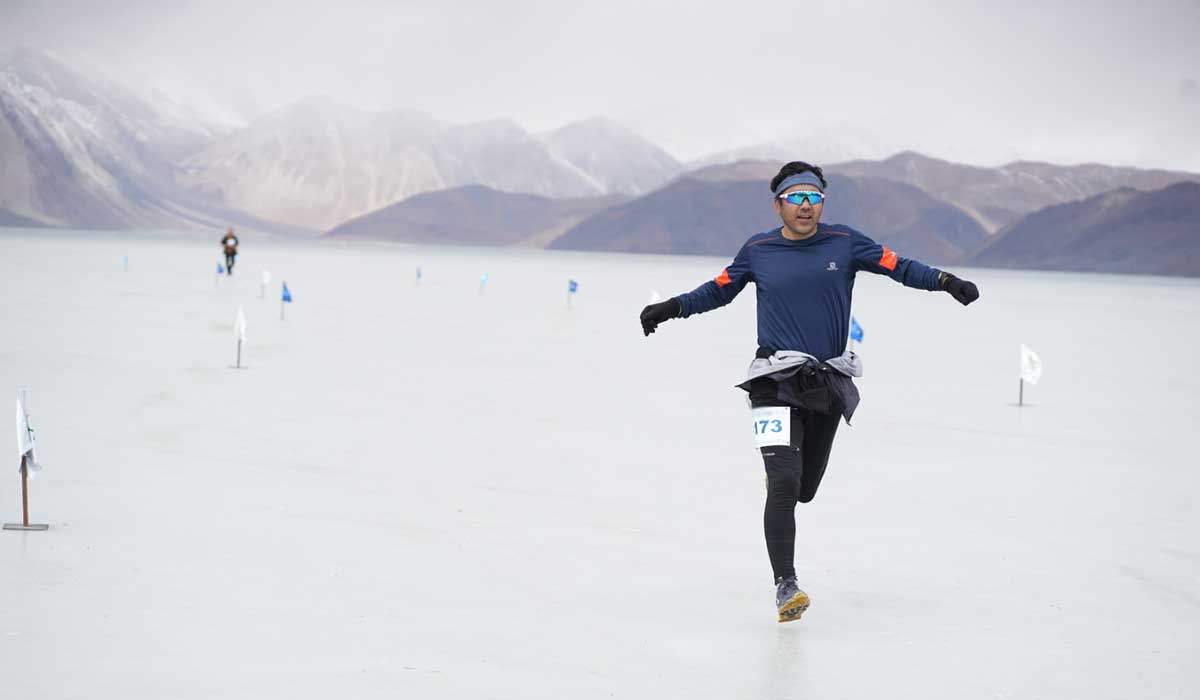
The frozen stage of Pangong Lake
The course follows a roughly circular track across the lake’s central basin, starting near Lukung and curving toward the remote settlements of Spangmik and Maan. Each stretch presents a new surface texture: polished ice that glimmers under the morning sun, powdery snowfields that test grip, and translucent cracks revealing dark water beneath. The 42.2 km full marathon includes alternating terrain designed for both speed and stamina, while the ultra-marathon extends into more rugged icy plains. Runners are guided by solar flags marking the safe path, monitored by experts who constantly assess ice thickness. The surface, while mesmerizing, is alive—it shifts, moans, and breathes beneath one’s feet. This dynamic terrain makes the Pangong race one of the most unpredictable marathons on Earth.
Altitude, acclimatization, and adaptation
At 4,225 meters (13,862 ft), Pangong Tso sits higher than most European alpine summits. Runners arriving from lower altitudes spend days in Leh to acclimatize, training in thin air and learning to recognize signs of altitude sickness. Even experienced marathoners find that speed takes a back seat to rhythm and breath control. The thin air challenges every heartbeat, forcing athletes to find balance between pace and oxygen intake. Those who adapt well describe the sensation as surreal—a meditative trance where mind and body synchronize with the vastness around them. In this altitude, even a slow jog feels heroic. Success here is measured not in minutes but in moments of survival and awareness.
Landmarks and the frozen horizon
The route offers rare glimpses of the winter landscape unseen by most travelers. On one side, the jagged peaks of the Chang Chenmo Range rise, their shadows stretching across the ice. On the other, the Tibetan plateau glows in pale gold. Each checkpoint becomes a miniature camp of warmth: Ladakhi volunteers serving butter tea, doctors checking oxygen saturation, and local musicians occasionally playing drums to keep spirits alive. The finish line is not a stadium but a humble banner fluttering against the wind—beyond it, a view so infinite that even exhaustion feels sacred. To cross that line is to complete not just a marathon, but an intimate dialogue with nature itself.
Heart, Cause, and Climate
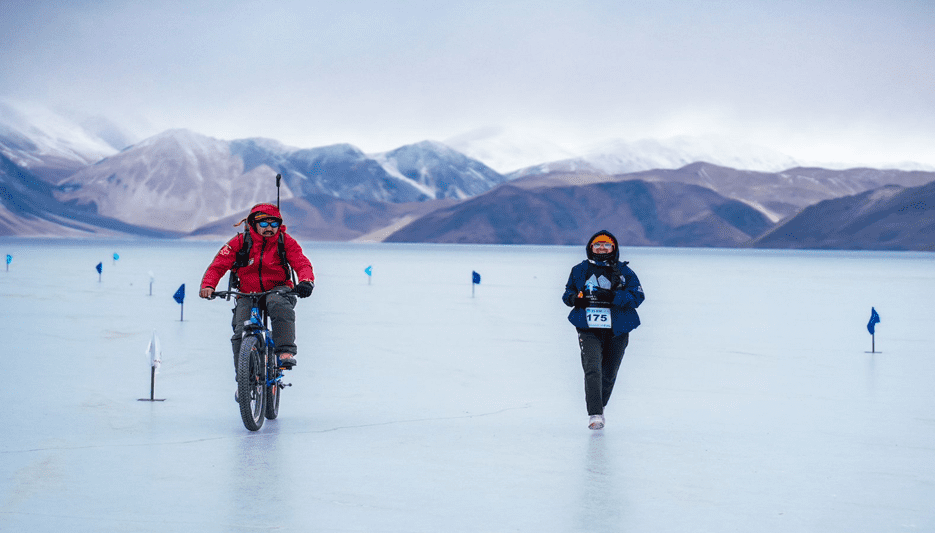
The deeper purpose behind “The Last Run”
The Pangong Frozen Lake Marathon carries a message beyond sport. By calling it “The Last Run,” organizers aim to draw attention to the fragility of Himalayan ecosystems. Ladakh’s glaciers are melting faster than ever, and Pangong’s frozen expanse shortens each year. Running on this ice becomes an act of awareness—a moving protest against the slow disappearance of the cold. Participants, many of them environmental advocates, share a common belief: that adventure and preservation can coexist. The marathon proves that tourism can be sustainable, community-based, and conscious of its impact. Each step on the ice echoes with a silent promise—to protect what gives it life.
Empowering local communities through adventure
The event also uplifts local livelihoods. Villagers from nearby hamlets provide logistical support, cook meals, and host participants in eco-homestays built with solar heating. The influx of visitors in the off-season brings economic stability to areas otherwise isolated during winter. ASFL ensures fair wages, gender inclusion, and environmental education for youth volunteers. For many locals, the marathon is more than a spectacle—it’s a bridge connecting them with the world. In turn, participants carry home not souvenirs, but stories of Ladakhi generosity and resilience. The human connection forged here becomes as lasting as the frozen lake itself.
Recognition, responsibility, and legacy
Since earning its Guinness World Record, the Pangong Frozen Lake Marathon has inspired similar eco-events across the Himalayas. Yet none match its purity or message. The 2026 race promises stricter sustainability protocols: biodegradable bibs, reusable hydration flasks, and complete waste retrieval. Beyond the medals, participants receive a symbolic memento—a carved stone etched with the words “Run for the Ice.” It serves as both a reminder and a call for responsibility. The legacy of this marathon lies not in numbers or records, but in its ability to unite adventure with stewardship—a lesson the world urgently needs.
How to Gear Up for the Frozen Frontier
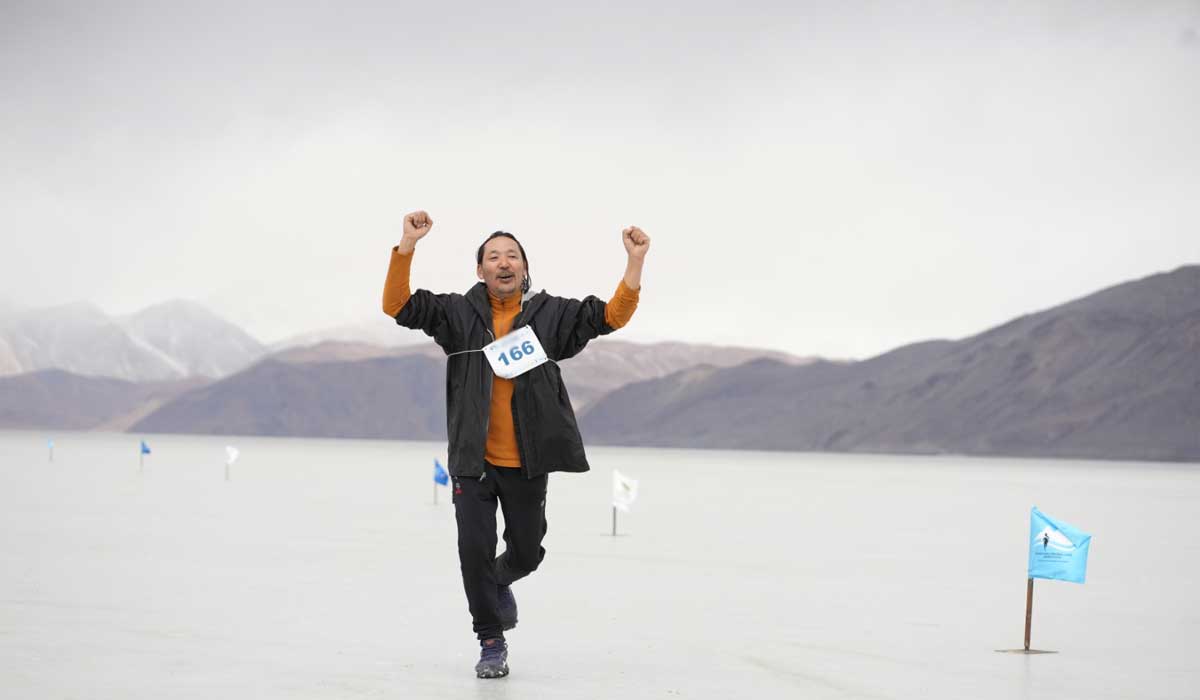
Training for altitude and cold
Preparation for Pangong demands discipline and respect for altitude science. Runners typically start training months in advance, combining endurance workouts with simulated altitude exposure or mountain hikes. Cardiovascular fitness is essential, but so is strength in stabilizing muscles that help maintain balance on ice. Cold-weather breathing techniques and controlled pacing are key. Mental fortitude matters as much as physical conditioning; running here means confronting discomfort with calm determination. Many participants describe the first few kilometers as bewildering—the mind questions, the body resists—but then, something shifts. The rhythm takes over, and the frozen silence becomes a teacher in endurance.
Essential gear for running on ice
Proper gear is non-negotiable. Layered thermal clothing, insulated gloves, windproof jackets, and traction spikes for shoes are mandatory. Sunglasses shield against snow blindness, while hydration packs prevent ice from forming inside bottles. Lightweight gaiters stop snow from entering shoes, and GPS trackers assist in case of sudden whiteouts. The organizers provide emergency support, but preparedness is personal. The combination of sun glare, subzero winds, and high-altitude dryness makes gear selection a science of survival. For many, the minimalism of gear mirrors the philosophy of the event—carry only what is essential, both on your body and in your thoughts.
Acclimatization and safety
All participants must arrive in Leh at least five days before the race. During this period, they rest, hydrate, and participate in short acclimatization runs. Medical teams monitor oxygen levels, ensuring that every runner is physically fit for the altitude. On race day, checkpoints with hot water, oxygen cylinders, and first aid are strategically placed. In case of emergency, snowmobiles stand ready for evacuation. Yet the event’s safety record remains exemplary, largely due to strict adherence to pre-race guidelines. The organizers’ mantra is clear: no pace is worth a risk. In the world’s highest frozen marathon, safety is the true measure of success.
Accessing the Frozen Stage
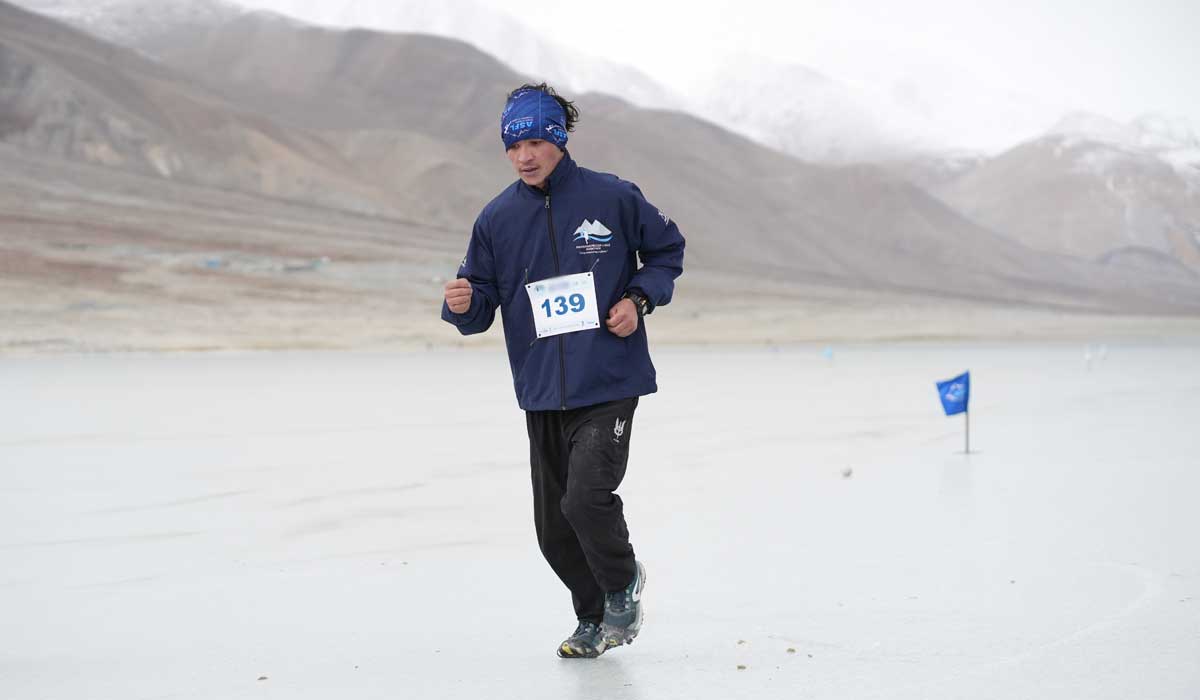
Journey from Leh to Pangong
The road to Pangong is an adventure in itself. From Leh, the 160-kilometer route winds through snow-covered passes and silent valleys. Convoys of vehicles move slowly, navigating icy curves under the watchful eye of the Indian Army, which ensures safe passage. The journey takes about six hours in winter conditions, offering views of monasteries cloaked in snow and villages seemingly frozen in time. The final stretch opens suddenly to the vast white plain of Pangong Lake—an otherworldly sight that justifies every mile. Travelers often describe this moment as a “curtain rising” on a stage of ice.
Permits, conditions, and local hospitality
Because Pangong lies close to the Indo-China border, special permits are required. The process is managed efficiently by the Ladakh Tourism Department, and marathon organizers assist participants in securing the necessary documents. Conditions along the route are challenging but manageable with proper planning. In the spirit of eco-tourism, accommodations prioritize sustainability: solar-powered lodges, locally sourced meals, and limited waste generation. In the evenings, bonfires and traditional music offer warmth and companionship, contrasting the lake’s frozen silence. The journey itself becomes part of the experience—a slow immersion into Ladakh’s winter rhythm.
Weather and timing for 2026
The marathon coincides with the coldest yet most stable phase of winter. Daytime temperatures hover around –15°C, while nights can plunge below –25°C. These extreme conditions, paradoxically, make the ice safest for running. The 2026 race is expected to feature clear skies and mirror-smooth ice, a photographer’s dream. Yet every participant learns quickly: beauty here demands caution. Sudden winds, thin cracks, and shifting ice plates remind runners that nature remains in control. Embracing unpredictability is part of the magic. After all, no two races on Pangong are ever the same.
Crossing Ice, Crossing Limits
What the ice teaches every runner
Those who finish the Pangong Frozen Lake Marathon speak of transformation. The exhaustion fades, but the memory of running on a frozen lake at the top of the world endures. The ice teaches lessons that extend far beyond the sport: patience, awareness, humility. Many return home realizing that the greatest endurance lies not in muscles but in mindset. It’s the art of staying calm in adversity, of finding grace in struggle. In a world obsessed with speed, this marathon offers something radical—slowness as strength, silence as wisdom. Each step across Pangong’s glassy surface becomes a metaphor for balance, fragility, and perseverance.
The evolving legacy of Pangong Marathon
Over the years, the Pangong Frozen Lake Marathon has redefined what adventure tourism means in the Himalayas. By integrating environmental advocacy and community empowerment, it shows that thrill and ethics can coexist. The 2026 edition strengthens this legacy by adding education programs on glacier preservation and plastic-free campaigns led by young Ladakhis. International recognition continues to grow, but the event’s soul remains local. To run here is to contribute to something larger than oneself—to leave no trace, but a lasting impression of respect for nature. That is the true victory of Pangong.
“At Pangong, every runner finds not competition, but communion—with ice, with altitude, and with their own endurance.”
Frequently Asked Questions — 2026 Edition
When and where is the Pangong Frozen Lake Marathon 2026 held?
The marathon will be held at Pangong Lake, Ladakh, on February 24 and 25, 2026. The event’s location lies around 160 kilometers east of Leh, along the frozen expanse of Pangong Tso.
What categories are available for runners?
Participants can choose between Full Marathon (42.2 km), Half Marathon (21.1 km), Amateur Run (10 km), and the new Pangong Ice Ultra (55 km) for seasoned endurance athletes.
How cold does it get during the marathon?
Temperatures can range from –10°C during midday to as low as –25°C in early morning or evening. Proper gear and acclimatization are essential for comfort and safety.
Is it safe to run on the frozen lake?
Yes, the ice is thoroughly inspected by experts for stability. Safety vehicles, medical teams, and rescue personnel are positioned along the course to ensure runner security.
Can beginners join the Pangong Marathon?
Beginners can participate in the 10 km category, provided they complete mandatory acclimatization and medical clearance. Preparation and caution remain vital for all runners.
How can participants register for the 2026 edition?
Registration is available through the official website of the Pangong Frozen Lake Marathon and includes options for accommodation, permits, and guided acclimatization programs.
What makes this marathon eco-friendly?
The marathon follows a strict “Leave No Trace” policy—biodegradable race materials, zero plastic use, and community clean-up drives ensure minimal environmental impact.
When Ice, Altitude, and Spirit Align
Why 2026 could be the most meaningful edition yet
The 2026 edition is more than a race—it’s a declaration of hope for Ladakh’s fragile high-altitude ecosystems. With new sustainability measures and deeper community engagement, it represents an evolution in adventure ethics. Each runner becomes part of a living narrative that celebrates endurance and environmental harmony. The sight of hundreds moving across a frozen mirror beneath a cobalt sky is not just breathtaking—it’s symbolic of humanity’s capacity to move forward responsibly, even in the harshest environments.
A final reflection for those who dream of the ice
To stand on Pangong’s frozen lake is to witness the union of extremes—silence and movement, fragility and strength, solitude and connection. The Pangong Frozen Lake Marathon is not merely an event to be attended; it is an experience to be absorbed. For those who crave meaning in motion, this race offers it in abundance. Here, at the edge of the sky, endurance becomes poetry. The ice remembers every footstep, every breath, every heartbeat that dared to cross its surface—and in doing so, it tells a timeless story of courage, respect, and the quiet beauty of running beyond limits.
View this post on Instagram

